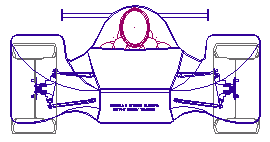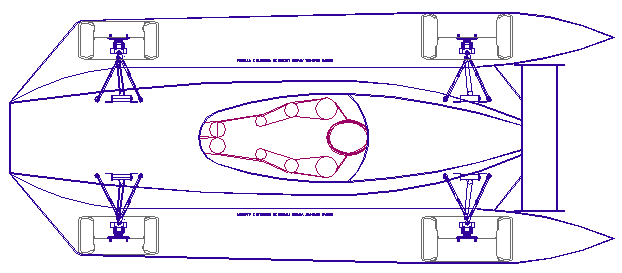|
FORMULA E - INSTANT RECHARGING
|
|||||||||||||||||||||||||||||||||||||||||||||||||||||||||||||||||||||||||||||||||||||||||||||||||||||||||||||||||||||||||||||
|
SMART GREEN & INTEGRATED TRANSPORT
This Challenge aims to boost the competitiveness of the European transport industries and achieve a European transport system that is resource-efficient, climate-and-environmentally-friendly, safe and seamless for the benefit of all citizens, the economy and society.
Ecostar club racer featuring the patent Bluebird™ instant recharging system that is ideal for sustainable smart cities. The sad news is that the company developing this cutting edge technology will not qualify for EU, Local Enterprise or TSB funding under the current rules that support companies with a trading record and university research, rather than start-ups with fresh ideas. In the 1990s the Dti refused funding for the development of a similar system on the pretext that there was no future for battery electric vehicles. That decision allowed competitor companies to gain the technology lead. Einstein said that imagination is more important than knowledge. We say that leadership requires imagination. Pity we can't bottle some up for the Dti.
TRA
2014 PARTNERING
EVENT - HORIZON 2020
http://www.traconference.eu/about-tra/registration.html
Simply check the box “I would like to participate in the partnering event”.
CONTACTS Ifsttar
To book a
stand contact:
TECHNOLOGY STRATEGY BOARD - CALL 2013/14
Funding at the 60% rate for SME's is no incentive to high risk development of disruptive technology. It is a recipe for disaster that the big players relish. They love nothing more than knocking down new players with smart ideas that threaten the production of existing vehicles, which they can then scoop up a few years later at no cost to themselves.
The Technology Board must know this, hence, the "call" is a means to flush out new ideas that inventors should be entitled to benefit from, at no cost to the establishment. One could argue that 60% funding is therefore perverse. Indeed, the patent system is perverse, for it requires huge sums of money from struggling innovators - just to acquire rights that a writer or film-maker gain automatically for free.
The system has got to change, to stop discrimination against the engineering profession. Engineers should be able to protect their work affordably.
RESEARCH & DEVELOPMENT: APC
The Department for Business, Innovation and Skills (BIS), in partnership with the Automotive Council and the Technology Strategy Board, is to invest up to £75m in collaborative R&D projects in the field of low carbon vehicles.
The competition will support a small number of projects that will form the initial portfolio for the Advanced Propulsion Centre (APC).
The APC is the centrepiece of the new joint industry and government strategy for the automotive sector and is being launched to help develop, commercialise and enable the manufacture of advanced propulsion technologies in the UK. The funding of these projects is a precursor to a steady state of funding throughout the lifetime of the APC.
The projects are expected to start in April 2014. They will strengthen UK capability and develop and grow the UK's propulsion systems supply chain. Projects must be collaborative and business-led. We expect total eligible project costs to be between £10m and £40m. The funding will be split between industrial research, with a business partner attracting 50% public funding for their project costs (60% for SMEs), and experimental development, with a business partner attracting 25% funding (35% for a medium-sized company and 45% for small enterprises). Projects are expected to last between 18 and 42 months.
This competition opens on 2 December 2013. The deadline for registration is at noon on 29 January 2014 and the deadline for applications is at noon on 5 February 2014.
A briefing event via webinar is to be held on 4 December 2013.
* Key features: Investment of up to £75m in collaborative R&D projects for low carbon vehicles. * Programme: Collaborative research and development * Award: Up to £75m * Opens: 03 Dec 2013 * Registration closes: 29 Jan 2014 * Closes: 05 Feb 2014 * Support Telephone Number: 0300 321 4356
COLLABORATION
Collaborative research and development (R&D) encourages businesses and researchers to work together on innovative projects in strategically important areas of science, engineering and technology – from which successful new products, processes and services can emerge, contributing to business and economic growth. Each £1 we invest in collaborative R&D typically returns around £7 in GVA (Gross Value Added).
CONTACTS
Email: support@innovateuk.org
Vessel Efficiency II - better systems at sea Enhancing Manufacturing through automation Disruptive technologies in low carbon vehicles II Vessel efficiency: Piloting UK marine and maritime innovation
EU HORIZON 2020 – WORK PROGRAMME 2014-2015
MG.8.2-2014. Next generation transport infrastructure: resource efficient,
smarter and safer Specific challenge: In order to increase the performance of infrastructure to accommodate
increasing transport demand, the 21st century transport infrastructure needs to be more
resource efficient, smarter and safer. This requires a range of innovative solutions, including
for intelligent traffic management, low-carbon construction and energy-harvesting. In order to
implement effective infrastructure management, advanced methods for data collection
(including automatic sensing) and analysis have to be developed. In addition, a better
integration of infrastructure in its natural habitat with a reduced intrusion of noise, air
Proposals can either focus on technological progress and further advancement in knowledge (Research and Innovation Actions) or on reinforcing networking among operators with a view to enhance the effectiveness of the sector (Coordination and Support Actions).
Expected impact: The work is expected to contribute to:
Head on view of a prototype Formula E design with the Bluebird™ instant refueling system incorporated. (see plan and side views below)
INSTANT PIT STOP RECHARGING FOR FORMULA E CARS
A high speed development of patent GB2253379 has yielded a chassis design for Formula E cars that does not radically change the aerodynamics, seating or weight distribution of a Formula E racing car. In fact the weight distribution can be improved over Formula 1.
The drawings on this page are of a basic prototype, closed cockpit design, incorporating a 246 liter (0.246m2) battery cartridge that can be exchanged in 10-15 seconds using an inbuilt loader. Such a cartridge could provide a 60-86kW/hr pack. Sufficient for 20-40 minute high speed laps, depending on the power of your car's motors, drag, etc. This is using standard Lithium Ion Polymer technology (Li-ion). More exotic lithium compounds may increase performance - and fuel cells are something to consider, where the cartridge used in the exchange system is compatible.
Compare this to these cars:
Put this into perspective for a moment. Any one of the vehicles above will have a significant range improvement if using the standard Bluebird™battery cartridge + of course instant recharging.
The cartridge can be modified only before it is adopted generally (not after), if the FIA would like to furnish us with their considered views - but the all new mechanism and connections may not be materially altered, and is subject to confidentiality by agreement until the patent specification is published (which must be in early 2014 according to the Intellectual Property Office).
Formula E teams may avail themselves of a free developer License from Bluebird Marine Systems Ltd. Once the formalities are completed, designers may see how the cartridge is shoehorned into the design featured here. They are free to detail design their own high-speed loading mechanism, based on this patent concept - the object being to lower cartridge exchange times which may yield exchanges is say 5 seconds - giving those teams incorporating the system, a massive advantage in lap time averages.
Side view of a prototype Formula E design with the Bluebird™ instant refueling system incorporated.
Plan view of a prototype Formula E design with the Bluebird™ instant refueling system incorporated. Please note that these designs are © Bluebird Marine Systems Ltd 2013.
ROAD CARS
Shai Agassi might want to take a peek at what is going on in Formula E, where refueling for urban vehicles may be speeded up considerably to make our world a 'Better Place.' Sorry Shai, we couldn't resist it.
UTILITIES
Bluebird Marine Systems (BMS) is looking to conduct a feasibility study on high speed cartridge refueling in cities, side by side with a distribution supply network. BMS is looking for collaborative risk share partners and academic institutions interested in reducing pollution. Enquiries from energy generation companies are particularly welcomed, with a view to increasing profitability via load-leveling.
Li-ion SPECIFICS Ref: Wikipedia
HOW IT ALL BEGAN
it all started in 1990/91, way before our involvement, with patent application GB2253379. This system was developed and fitted into the BE1 land speed record vehicle seen on the left in the drawings below - and in the brochures and articles that follow.
A brochure produced to attract sponsors to the BE1 project for 1995/6. The patented cartridge exchange refueling system is cited as the key technology for the attempt. Not a bad looking car and as it turned out, quite fast - more than capable of taking the 175mph record at the time. This car achieved 160mph unofficially on a section of closed road with 80kW (107hp) motors - the short length of useable road being a limiting factor. She was designed to use 160kW (214 hp) motors for the WLSR attempt - all wheel drive, thus should have caned the then existing record of 175mph. The BE1 chassis was incredibly light and could be lifted above the head with one hand. The cartridge system further reduced the mass of the vehicle between runs. The big sister to the BE1, the BE2, was to have run with 320kW and double the cartridge capacity.
By October of 1995 Kitcars International had done an article as seen in the pages above. You can see this is the same photograph used in the brochure above. It was taken in front of Filching Manor, near Polegate in Sussex with kind permission of Paul Foulkes-Halbard - a dear friend now departed.
By September of 1997 the project had progressed as the land speed record had been raised, necessitating a faster design. Don Wales is pictured in this edition of Auto Express beside the BE2 (top) and the BE1 (lower). You can see a schematic of the BE2 in the drawings above and compare that to the BE3 to see just how much more advanced the new car is.
100 years old this year - the Detroit electric car from 1914. With more than 100,000 electric cars on U.S. roads - and thousands more added each month - advocates and historians are turning their attention to the last time cars with plugs rolled out of U.S. factories, almost 100 years ago. But as far as we know, there's no single museum or entity in the U.S. whose sole mission is to present the history of plug-in electric cars. That may be about to change, if a post in electric-vehicle forum Electrifying Times by collector and historian Roderick Wilde is any indication.
+44 (0) 1323 831727 +44 (0) 7842 607865
THE BLUE BIRDS OF HAPPINESS
ENERGY LINKS:
Wow! At last solar panels on production cars. Henry would love it.
FORMULA E LINKS:
Birmingham Super Prix return and the Formula E series Bluebird™ FE instant pit stop recharging system for Formula E cars* Pit Stops - servicing and history of the sport E Mag USA new standards for cleaner cars http://www.washingtonpost.com/epa-proposes-requiring-cleaner-fuel-cars-in-the-us Modal shift and decongestion of transport corridors The Fuel Cells and Hydrogen Joint Technology Initiative
*
The world's fastest electric circuit racers need a system to recharge batteries instantly during pit stops. The Formula E concept design above incorporates the patent Bluebird™ instant energy transfer system - allowing EV refuelling in around 10 seconds. Get your free developer License from Bluebird Marine Systems Ltd.
|
|||||||||||||||||||||||||||||||||||||||||||||||||||||||||||||||||||||||||||||||||||||||||||||||||||||||||||||||||||||||||||||
|
This
website is Copyright © 2014 Bluebird Marine Systems Limited.
The names Bluebird™,Blueplanet
BE3 Ecostar DC50™, Utopia
Tristar™ and the blue bird in flight
|
|||||||||||||||||||||||||||||||||||||||||||||||||||||||||||||||||||||||||||||||||||||||||||||||||||||||||||||||||||||||||||||
























